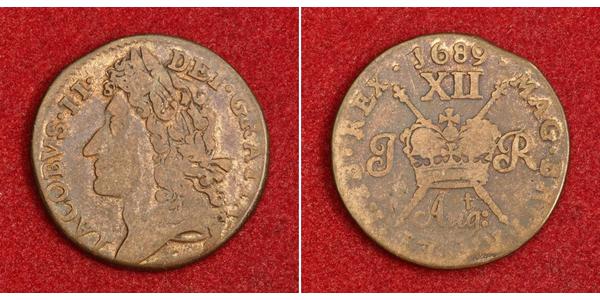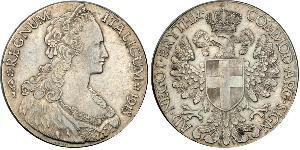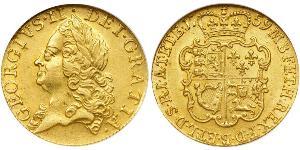1689, Ireland, James II. Scarce Civil War Gunmoney Shilling Coin. F+
Reference: KM-94. R! Condition: A well-circulated F+ Mint Year: 1689 (Aug - for August) Denomination: "Gunmoney" Shilling Material: Brass (so-called gun metal) Diameter: 25mm Weight: 5.77gm
Obverse: Laureate, draped bust of king James II left. Legend: IACOBVS • II • DEI • GRATIA Reverse: Value (XII) above crossed scepters behind crown. Initials (J-R) in fields. Month (Augt:) below. Legend: MAG • BR • FRA • ET • HIB • REX • 1689 •
In 1688 James II fled from England to France and the English crown passed to his daughter Mary and her husband William of Orange. After drumming up Catholic support on the Continent, James landed in Ireland in March 1689 to continue his struggle to regain control. Having insufficient funds to underwrite his war efforts, a plan was devised to issue official base metal token coins which would be exchanged for sterling silver once the war was won. Shortly after the inception of their issue, months were added to the dates to facilitate a staggered redemption plan once the war was over. The coins were made of brass from old cannon, bells, and other scrap metal. They would later become known as 'Gunmoney' coins. After William III seized the Dublin mint following the Battle of the Boyne, the coins were demonetized.
em>.
James II and VII (14 October 1633 – 16 September 1701) was King of England, Scotland, and Ireland from 6 February 1685. He was the last Catholic monarch to reign over the Kingdoms of England, Scotland, and Ireland. Some of James's subjects were unhappy with James's belief in absolute monarchy and opposed his religious policies, leading a group of them to depose him in the Glorious Revolution. The Parliament of England deemed James to have abdicated on 11 December 1688. The Parliament of Scotland on 11 April 1689 declared him to have forfeited the throne. He was replaced not by his Catholic son, James Francis Edward, but by his Protestant daughter, Mary II, and his son-in-law, William III. William and Mary became joint rulers in 1689. James II made one serious attempt to recover his crowns, when he landed in Ireland in 1689 but, after the defeat of the Jacobite forces by the Williamite forces at the Battle of the Boyne in the summer of 1690, James returned to France. He lived out the rest of his life under the protection of his cousin and ally, King Louis XIV.
James is best known for his belief in absolute monarchy and his attempts to create religious liberty for his subjects. Both of these went against the wishes of the English Parliament and of most of his subjects. Parliament, opposed to the growth of absolutism that was occurring in other European countries, as well as to the loss of legal supremacy for the Church of England, saw their opposition as a way to preserve what they regarded as traditional English liberties. This tension made James's three-year reign a struggle for supremacy between the English Parliament and the Crown, resulting in his deposition, the passage of the English Bill of Rights, and the Hanoverian succession.

|
Posted by:
anonymous 2018-07-31 |
2 Liard Austrian Netherlands (1713-1795) Copper
group has 3 coins / 3 prices
⇑
990 coins were uploaded from 2025-05-21 to 2025-05-28
One of them is:















-300-150-zTgKbzbixN4AAAFSpQBzJO3T.jpg)







